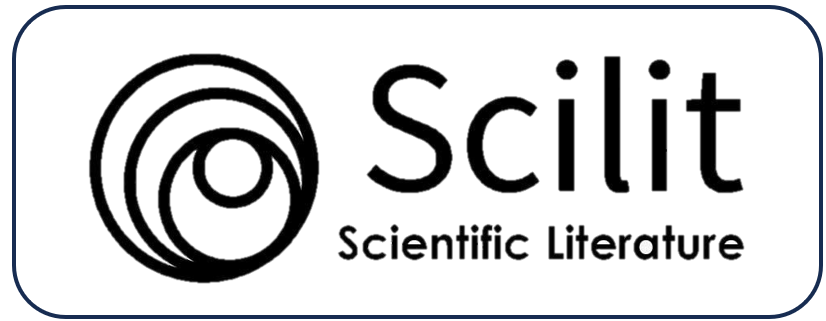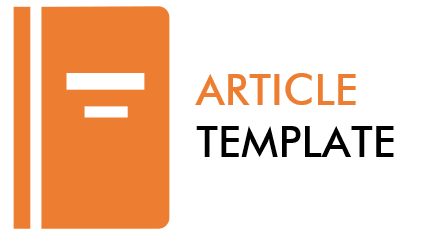| Open Acces Statement |
| Focus and Scope |
| Publication Ethics |
| Author Fees |
| Editorial Team |
| Reviewer |
| Retraction |
| Screening for Plagiarism |
| Peer Review Process |
| Online Submissions |
Author Guidelines
Author Guidelines
- Articles submitted to the Journal should not normally exceed 6,000 words (15 to 20 pages) with single space and should be accompanied by an abstract in Bahasa and English should be 150 to 200 words. The Abstract should be informative and completely self-explanatory of fundamental findings, objectives, methods, instruments, participants, and findings.
- The name of the author should be written without academic titles and placed under the title of the article, followed by the name of the institution and mailing address. If the manuscript is written by a team, all members of the team must be written. However, the editor only deals with the main author or whose name is in the first place.
- The articles should be written in the following systematic order: title, author’s name, address of institution and correspondence (e-mail address), abstrak, kata kunci, abstract; keywords; introduction (containing research problems, current scientific situation, may refer to the literature on which research is based); method; findings and discussion (reinforced by relevant research theories or findings); conclusion, and references.
- The main text format consists of flat left-right columns on A4 paper (quarto). The margin text from the left, right, top, and bottom 3 cm. The manuscript is written in Microsoft Word, single space, Tahoma 11.5pt.
- The page number should be inserted at the top, placed on the right and left.
- Write the main body of the article in one column, except for tables and figures. Use first line indent of 1 cm, but no indent for the first paragraph right after the main title and first paragraph after subheadings.
- Block citation should be 1 cm indented with the font size 11.
- The title should be less than 14 words, Center, Bold, Capitalize Each Word, Tahoma 15pt.
- The introduction should consist of the background of the study, research contexts, literary review, and research objective. All introduction should be presented in the forms of paragraphs, not pointers, with the proportion of 15-20% of the whole article length.
- The method section consists of a description concerning the research design, data sources, data collection, and data analysis with the proportion of 10-15% of the total article length, all presented in the form of paragraphs.
- The findings and discussion section consist of the description of the results of the data analysis to answer the research question(s) and their meanings are seen from current theories and references of the area addressed. The proportion of this section is 40-60% of the total article length.
- The conclusion section consists of the summary, restatement of the main findings.
- Use only horizontal lines when using tables. Put the table number and the title of the table on top of it.
- Every source cited in the body of the article should appear in the reference, and all sources appearing in the reference should be cited in the body of the article.
- The sources cited should at least 80% come from those published in the last 10 years. The sources cited are primary sources in the forms of journal articles, books, and research reports, including theses and dissertations. Citations from the journal should be at least 80% of the total references cited.
- The citation is done using a bracket (last name and year of publication). When the sources are cited verbatim, the page number is included (p. 78 or pp. 78-89).
- Quotation and references follow APA 7th edition style and the latter should be included at the end of the article in the following examples:
Books
General Format for 1 Author
In-Text Citation (Paraphrase):
(Author Surname, Year) OR (Author Surname, Year, page number)
In-Text Citation (Quotation):
(Author Surname, Year, page number)
References:
Author Surname, First Initial. Second Initial. (Year). Book title: Subtitle. Place of Publication: Publisher.
Example with 1 Author
In-Text Citation (Paraphrase):
(Mayer, 2010)
In-Text Citation (Quotation):
(Mayer, 2010, p. 10)
References:
Mayer, D. (2010). Essential evidence-based medicine (2nd ed.). Cambridge, England: Cambridge University Press.
General Format with 2 Author
In-Text Citation (Paraphrase):
(Author Surname & Author Surname, Year) OR (Author Surname & Author Surname, Year, page number)
In-Text Citation (Quotation):
(Author Surname & Author Surname, Year, page number)
References:
Author Surname, First Initial. Second Initial., & Author Surname, First Initial. Second Initial. (Year). Book title: Subtitle. Place of Publication: Publisher.
Example with 2 Authors
In-Text Citation (Paraphrase):
(Abigail & Cahn, 2011)
In-Text Citation (Quotation):
(Abigail & Cahn, 2011, p. 219)
References:
Abigail, R., & Cahn, D. (2011). Managing conflict through communication(4th ed.). Boston, MA: Allyn & Bacon.
General Format with 3-5 Author
In-Text Citation (Paraphrase):
(Author Surname, Author Surname, & Author Surname, Year) OR (Author Surname, Author Surname, & Author Surname, Year, page number)
NOTE: Although the first in-text citation for a work with three to five authors/editors includes all of the names of the authors/editors, subsequent citations include only the first author's/editor's surname, followed by et al. and the year.
In-Text Citation (Direct Quote):
(Author Surname, Author Surname, & Author Surname, Year, page number)
References:
Author Surname, First Initial. Second Initial., Author Surname, First Initial. Second Initial., Author Surname, First Initial. Second Initial., Author Surname, First Initial. Second Initial., & Author Surname, First Initial. Second Initial. (Year). Book title: Subtitle. Place of Publication: Publisher.
Example with 3-5 Authors
In-Text Citation (Paraphrase):
(Glasgow, McNary, & Hicks, 2006)
NOTE: A subsequent citation would appear as (Glasgow et al., 1999)
In-Text Citation (Quotation):
(Glasgow, McNary, & Hicks, 2006, p. 59)
References:
Glasgow, N. A., McNary, S. J., & Hicks, C. D. (2006). What successful teachers do in diverse classrooms. Thousand Oaks, CA: Corwin Press.
Journal/Magazine Article
General Format with 1 Author
In-Text Citation (Paraphrase):
(Author Surname, Year) OR (Author Surname, Year, page number)
In-Text Citation (Quotation):
(Author Surname, Year, page number)
References:
Author Surname, First Initial. Second Initial. (Year). Article title: Subtitle. Journal Title, Volume(issue), page range. doi:xx.xxxxxxxxxx ORhttp://dx.doi.org/xx.xxxxxxxxxx OR Retrieved from URL of journal homepage [if available]
Example with 1 Author
In-Text Citation (Paraphrase):
(Smith, 2011)
In-Text Citation (Quotation):
(Smith, 2011, p. 13)
References:
Smith, J. (2011). Agency and female teachers' career decisions: A life history study of 40 women. Educational Management Administration & Leadership, 39, 7-24. doi:10.1177/1741143210383900
General Format with 2 Author
In-Text Citation (Paraphrase):
(Author Surname & Author Surname, Year) OR (Author Surname & Author Surname, Year, page number)
In-Text Citation (Quotation):
(Author Surname & Author Surname, Year, page number)
References:
Author Surname, First Initial. Second Initial., & Author Surname, First Initial. Second Initial. (Year). Article title: Subtitle. Journal Title, Volume(issue), page range. doi:xx.xxxxxxxxxx OR http://dx.doi.org/xx.xxxxxxxxxx OR Retrieved from URL of journal homepage [if available]
Example with 2 Authors
In-Text Citation (Paraphrase):
(Browne & Hemsley, 2010)
In-Text Citation (Quotation):
(Browne & Hemsley, 2010, p. 25)
References:
Browne, G., & Hemsley, M. (2010). Housing and living with a mental illness: Exploring carers' views. International Journal of Mental Health Nursing, 19, 22-29. doi:10.1111/j.1447-0349.2009.00635.x
General Format with 3-5 Author
In-Text Citation (Paraphrase):
(Author Surname, Author Surname, & Author Surname, Year) OR (Author Surname, Author Surname, & Author Surname, Year, page number)
NOTE: Although the first in-text citation for a work with three to five authors/editors includes all of the names of the authors/editors, subsequent citations include only the first author's/editor's surname, followed by et al. and the year.
In-Text Citation (Quotation):
(Author Surname, Author Surname, & Author Surname, Year, page number)
References:
Author Surname, First Initial. Second Initial., Author Surname, First Initial. Second Initial., & Author Surname, First Initial. Second Initial. (Year). Article title: Subtitle. Journal Title, Volume(issue), page range. doi:xx.xxxxxxxxxx OR http://dx.doi.org/xx.xxxxxxxxxx OR Retrieved from URL of journal homepage [if available]
Example with 3-5 Authors
In-Text Citation (Paraphrase):
(James, Hart, Bailey, & Blinn, 2009)
NOTE: A subsequent citation would appear as (James et al., 2009)
In-Text Citation (Quotation):
(James, Hart, Bailey, & Blinn, 2009, p. 249)
References:
James, K. R., Hart, B. T., Bailey, P. C. E., & Blinn, D. W. (2009). Impact of secondary salinization on freshwater ecosystems: Effect of experimentally increased salinity on an intermittent floodplain wetland. Marine and Freshwater Research, 60, 246-258. doi:10.1080/02615470020028364
General Format (Magazine Article)
In-Text Citation (Paraphrase):
(Author Surname, Year) OR (Author Surname, Year, page number)
In-Text Citation (Quotation):
(Author Surname, Year, page number)
References:
Author Surname, First Initial. Second Initial. (Year, Month Day). Article title: Subtitle. Magazine Title, page range. Retrieved from URL of magazine homepage [if viewed online].
Example (Magazine Article)
In-Text Citation (Paraphrase):
(Rick & Erlandson, 2009)
In-Text Citation (Quotation):
(Rick & Erlandson, 2009, p. 952)
References:
Rick, T. C., & Erlandson, J. M. (2009, August 21). Coastal exploitation. Science, 325, 952-953.
Kuttner, R. (2003, September 8). The great American pension-fund robbery. Business Week, 24-26. Retrieved from http://www.businessweek.com/
General Format (Newspaper Article)
In-Text Citation (Paraphrase):
(Author Surname, Year) OR (Author Surname, Year, page number)
In-Text Citation (Quotation):
(Author Surname, Year, page number)
References:
Author Surname, First Initial. Second Initial. (Year, Month Day). Article title: Subtitle. Newspaper Title, page range. Retrieved from URL of newspaper homepage [if viewed online].
Example (Newspaper Article)
In-Text Citation (Paraphrase):
(Browne, 2010)
In-Text Citation (Quotation):
(Browne, 2010, p. 7)
References:
Browne, R. (2010, March 21). This brainless patient is no dummy. The Sydney Morning Herald, p. 7.
Hutcheon, S. (2011, March 25). iPad 2 leading the charge. The Brisbane Times. Retrieved from http://www.brisbanetimes.com.au
Website
General Format (Basic Web Page/Document on Web Page)
In-Text Citation (Paraphrase):
(Author Surname, Year) OR (Author Surname, Year, page or paragraph number [if available])
In-Text Citation (Quotation):
(Author Surname, Year, page or paragraph number [if available])
References:
Personal or Corporate Author. (Last update or copyright date; if not known, put n.d.). Title of a specific document. Retrieved from URL of the specific document
Example (Basic Web Page/Document on Web Page)
In-Text Citation (Paraphrase):
(Beard, 2006)
In-Text Citation (Quotation):
(Beard, 2006, para. 12)
References:
Beard, M. (2006). The fall of the Roman Republic. Retrieved from http://www.bbc.co.uk/history/ancient/romans/fallofroman republic_article_01.shtml
Department of Health. (2015). Australian national diabetes strategy: 2016-2020. Retrieved from http://www.health.gov.au/publishing.nsf/ content/AustralianNationalDiabetesStrategy2016-2020.pdf
General Format (Web Page with No Date)
In-Text Citation (Paraphrase):
(Author Surname, n.d.) OR (Author Surname, n.d., page or paragraph number [if available])
In-Text Citation (Quotation):
(Author Surname, n.d., page or paragraph number [if available])
References:
Personal or Corporate Author. (n.d.). Title of a specific document. Retrieved from URL of the specific document
Example (Web Page with No Date)
In-Text Citation (Paraphrase):
(Royal Institute of British Architects, n.d.)
In-Text Citation (Quotation):
(Royal Institute of British Architects, n.d., para. 3)
References:
Royal Institute of British Architects. (n.d.). Shaping the future: Careers in architecture. Retrieved from http://ww.careersinarchitecture.net/
Conferences Papers and Proceedings
General Format (Published in a Book)
In-Text Citation (Paraphrase):
(Author Surname, Year) OR (Author Surname, Year, page number)
In-Text Citation (Quotation):
(Author Surname, Year, page number)
References:
Author Surname, First Initial. Second Initial. (Year). Conference paper title. In Editor First Initial. Editor Surname (Ed.), Proceedings Book Title (pp. page range of paper). Place of Publication: Publisher.
Example (Published in a Book)
In-Text Citation (Paraphrase):
(Armstrong, Fogarty, & Dingsdag, 2007)
In-Text Citation (Quotation):
Armstrong, Fogarty, & Dingsdag, 2007, p. 165
References:
Armstrong, D. B., Fogarty, G. J., & Dingsdag, D. (2007). Scales measuring characteristics of small business information systems. In W-G. Tan (Ed.), Proceedings of Research, Relevance and Rigour: Coming of age: 18th Australasian Conference on Information Systems (pp. 163-171). Toowoomba, Australia: University of Southern Queensland.
General Format (Published Online)
In-Text Citation:
(Author Surname, Year)
References:
Author Surname, First Initial. Second Initial. (Year, Month). Conference paper title. Paper presented at the Conference Title, Place, US state/country. Retrieved from URL
Example (Published Online)
In-Text Citation:
(Taylor, 2006)
References:
Taylor, J. A. (2006, November). Assessment: a tool for development and engagement in the first year of university study. Paper presented at the Engaging Students: 9th Pacific Rim in Higher Education (FYHE) Conference, Griffith, Australia. Retrieved from http://www.fyhe.com.au/past_papers/2006/Papers/Taylor.pdf
Bird, R. B., Tayor, N., Codding, B. F., & Bird, D. W. (2013). Niche construction and Dreaming logic: Aboriginal patch mosaic burning and varanid lizards (Varanus gouldii) in Australia. Proceedings of the Royal Society B, 280 20132297, doi:10.1098/rspb.2013.229
General Format (Unpublished)
In-Text Citation:
(Author Surname, Year)
References:
Author Surname, First Initial. Second Initial. (Year, Month). Conference paper title. Paper presented at the Conference Title, Place, US State or Country.
Example (Unpublished)
In-Text Citation (Paraphrase):
(Green & De Silva, 2015)
References:
Green, D. B. & DeSilva, A. (2015, June). The toxicity levels of household chemicals. Paper presented at the National Symposium on Air Pollution, University of Southern California, California.
Theses
General Format (Published Thesis)
In-Text Citation (Paraphrase):
(Author Surname, Year) OR (Author Surname, Year, page number)
In-Text Citation (Quotation):
(Author Surname, Year, page number)
References:
Author Surname, First Initial. Second Initial. (Year). Thesis title(PhD/DBA/Masters thesis). Retrieved from Name of database. (Accession or Order No.)
Example (Published Thesis)
In-Text Citation (Paraphrase):
(Baker, 2008)
In-Text Citation (Quotation):
(Baker, 2008, p. 10)
References:
Baker, C. A. (2008). The seduction of loss (PhD thesis). Retrieved from ProQuest Dissertations and Theses database. (UMI No. 1234567)
General Format (Unpublished Thesis)
In-Text Citation (Paraphrase):
(Author Surname, Year) OR (Author Surname, Year, page number)
In-Text Citation (Quotation):
(Author Surname, Year, page number)
References:
Author Surname, First Initial. Second Initial. (Year). Thesis title (Unpublished PhD/DBA/Masters thesis). Name of Institution, Location.
Example (Unpublished Thesis)
In-Text Citation (Paraphrase):
(Baker, 2008)
In-Text Citation (Quotation):
(Baker, 2008, p. 10)
References:
Hardcopy:
Baker, C. A. (2008). The seduction of loss (Unpublished PhD thesis). Southern Cross University, Lismore, Australia.
Institutional repository:
Baker, C. A. (2008). The seduction of loss (Unpublished PhD thesis). Retrieved from http://epubs.scu.edu.au/theses
Submission Preparation Checklist
As part of the submission process, authors are required to check off their submission's compliance with all of the following items, and submissions may be returned to authors that do not adhere to these guidelines.
- The submission has not been previously published, nor is it before another journal for consideration (or an explanation has been provided in Comments to the Editor).
- The submission file is in OpenOffice, Microsoft Word, RTF, or WordPerfect document file format.
- Where available, URLs for the references have been provided.
- The text is single-spaced; uses a 12-point font; employs italics, rather than underlining (except with URL addresses); and all illustrations, figures, and tables are placed within the text at the appropriate points, rather than at the end.
- The text adheres to the stylistic and bibliographic requirements outlined in the Author Guidelines, which is found in About the Journal.
- If submitting to a peer-reviewed section of the journal, the instructions in Ensuring a Blind Review have been followed.























